
Sparidae is a family of ray-finned fishes belonging to the order Spariformes, the seabreams and porgies, although they were traditionally classified in the order Perciformes. They are found in shallow temperate and tropical waters around the world and are demersal carnivores.
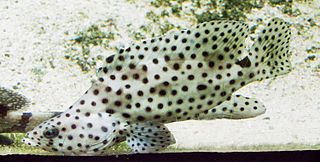
Serranidae is a large family of fishes belonging to the order Perciformes. The family contains about 450 species in 65 genera, including the sea basses and the groupers. Although many species are small, in some cases less than 10 cm (3.9 in), the giant grouper is one of the largest bony fishes in the world, growing to 2.7 m in length and 400 kg (880 lb) in weight. Representatives of this group live in tropical and subtropical seas worldwide.

The Scorpaeniformes are a diverse order of ray-finned fish, including the lionfishes and sculpins, but have also been called the Scleroparei. It is one of the five largest orders of bony fishes by number of species, with over 1,320.

The butterflyfish are a group of conspicuous tropical marine fish of the family Chaetodontidae; the bannerfish and coralfish are also included in this group. The approximately 129 species in 12 genera are found mostly on the reefs of the Atlantic, Indian, and Pacific Oceans. A number of species pairs occur in the Indian and Pacific Oceans, members of the huge genus Chaetodon.

Rhamphocottidae is a family of ray-finned fishes belonging to the superfamily Cottoidea, the sculpins. The species in this family occur in the North Pacific Ocean.

Caproidae, or boarfishes, are a small family of marine fishes comprising two genera and 19 species. These fishes are found throughout the world in temperate and tropical seas.
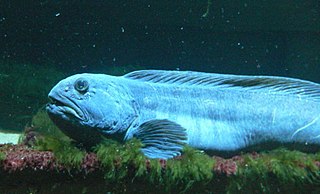
Zoarcoidei is a suborder of marine ray-finned fishes belonging to the order Perciformes. The suborder includes the wolffishes, gunnels and eelpouts. The suborder includes about 400 species. These fishes predominantly found in the boreal seas of the northern hemisphere but they have colonised the southern hemisphere.

The Gobiiformes are an order of fish that includes the gobies and their relatives. The order, which was previously considered a suborder of Perciformes, is made up of about 2,211 species that are divided between seven families. Phylogenetic relationships of the Gobiiformes have been elucidated using molecular data. Gobiiforms are primarily small species that live in marine water, but roughly 10% of these species inhabit fresh water. This order is composed chiefly of benthic or burrowing species; like many other benthic fishes, most gobiiforms do not have a gas bladder or any other means of controlling their buoyancy in water, so they must spend most of their time on or near the bottom. Gobiiformes means "goby-like".

Acanthomorpha is an extraordinarily diverse taxon of teleost fishes with spiny fin rays. The clade contains about one-third of the world's modern species of vertebrates: over 14,000 species.
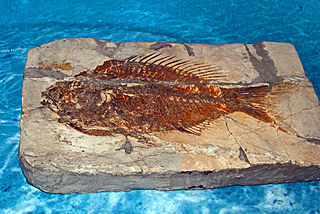
Sparnodus is an extinct genus of prehistoric perciform fish in the family Sparidae. Species of this genus were nektonic carnivores. These fishes lived in the Cenozoic Era, in the Oligocene and Paleocene.

Cottoidei is a suborder of ray-finned fishes which, according to the 5th edition of Fishes of the World, is placed within the order Scorpaeniformes, alongside the scorpionfishes, flatheads, eelpouts, sticklebacks and related fishes.

Cichliformes is an order of fishes. Its members were previously classified under the order Perciformes, but now many authorities consider it to be an independent order within the subseries Ovalentaria.

Cyclopoma is an extinct genus of marine perciform fish from the Eocene. It is known from the Ypresian to the Lutetian of Europe and eastern North America.

Callionymiformes is an order of bony fish containing two families, the dragonets Callionymidae and the Draconettidae. In some taxonomies these families make up the suborder Callionymoidei of the wider grouping known as Perciformes, Nelson (2016) recognised the order but subsequent workers have suggested that if Callionymiformes is recognised as an order then the order Syngnathiformes is rendered paraphyletic and include Callionmyoidei within that taxon.

Aulostomoidei is a superfamily of the order Syngnathiformes, which also contains groups such as the seahorses, pipefishes and dragonets. It is one of two superfamilies which make up the suborder Aulostomoidei within the Syngnathiformes.
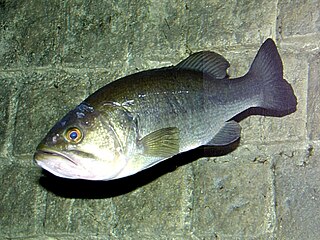
Centrarchiformes is an order of ray-finned fish, previously included amongst the perciformes, with 20 families. This order first appeared about 55.8 million years ago in the Eocene Era, and is composed primarily of omnivores. The order has a wide range that includes the continents of Australia and South America. Many Centrarchiformes look essentially perch-like, featuring a stocky build and a spine-bearing dorsal fin, and range in size from 2.5 cm in length, to 1.8 meters for the Maccullochella peelii. The order Centrachiformes is not recognized in the 5th Edition (2016) of Fishes of the World, but is accepted on the World Register of Marine Species in November 2023 and Fishbase.
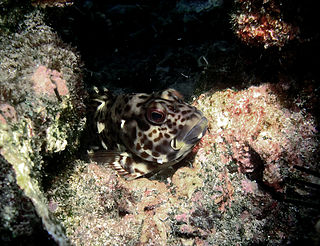
Cirrhitoidea is a superfamily within the suborder Percoidei of the large order of ray-finned fishes, the Perciformes.
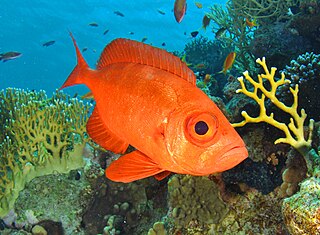
The Priacanthiformes is a proposed order of marine ray-finned fishes. The order comprises two families, the Priacanthidae and the Cepolidae, which bear very little morphological similarity to each other but which have been shown to be sister taxa in repeated molecular analyses. The exact placement of the order within the series Eupercaria is incertae sedis. However, the more traditional classification followed in the 5th Edition of the Fishes of the World places both these families within the order Perciformes.

Siganoidea is a superfamily belonging to the suborder Percoidei which in turn is the largest suborder of the order Perciformes. It contains two families of largely Indo-Pacific distribution.
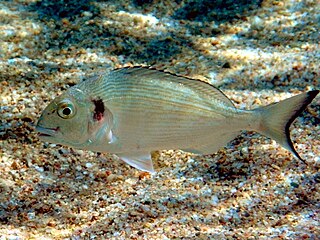
Spariformes is an order of ray-finned fishes consisting of six families within the series Percomorpha.






















